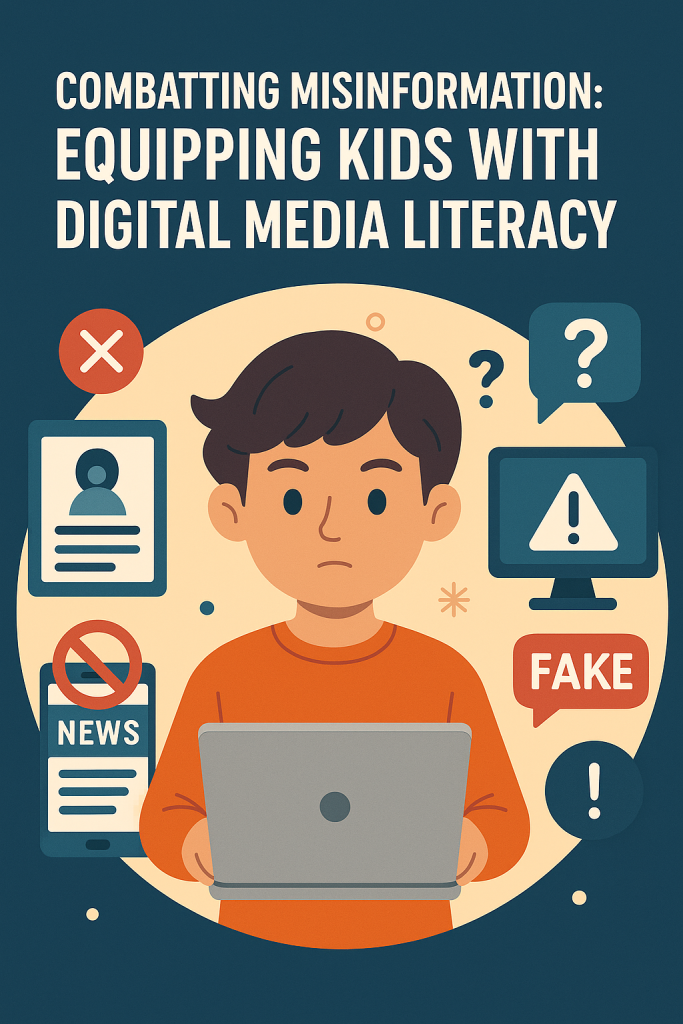Equipping Kids with Digital Media Literacy
Understanding the Urgency of Digital Media Literacy for Children
In today’s hyperconnected society, children are exposed to an unprecedented volume of digital content. From YouTube videos and social media posts to online games and news articles, the information landscape is saturated with content that is not always accurate or trustworthy. This digital saturation makes digital media literacy not just a useful skill but a critical life competency for children growing up in the information age.
The rise in misinformation, disinformation, and manipulative content online threatens the cognitive development and emotional well-being of young audiences. Without the proper tools to distinguish fact from fiction, children are at risk of forming distorted worldviews, engaging in harmful behaviors, or becoming easy targets for online scams, radicalization, or emotional manipulation.
What is Digital Media Literacy?
Digital media literacy refers to the ability to access, analyze, evaluate, create, and act on digital content in a critical, responsible, and informed way. For children, this means more than just recognizing fake news. It includes understanding how algorithms shape online experiences, being able to detect bias or hidden agendas, and maintaining healthy habits when interacting with digital platforms.
Developing these skills early helps children become active participants in the digital ecosystem rather than passive consumers, promoting resilience against misleading narratives and digital exploitation.
The Role of Parents and Educators
Equipping children with digital media literacy is not a task reserved for tech companies or governments alone. Parents and educators are on the frontlines of this battle against misinformation. By integrating media literacy education into the home and classroom, we empower kids with tools to interpret the content they engage with daily.
Tips for Parents to Foster Media Literacy at Home
- Co-view and co-play: Watch videos, browse the internet, or play games together to open discussions about content, advertising, and credibility.
- Ask critical questions: “Who made this?” “What do they want me to think or feel?” “Is this a trusted source?”
- Model skepticism and verification: Let children see you fact-checking information and using multiple sources before forming opinions.
- Limit screen time wisely, ensuring balance and space for real-world critical thinking and reflection.
Integrating Media Literacy into School Curricula
Schools play a fundamental role in normalizing critical media engagement. Across subjects—from language arts to social studies—educators should embed skills like source evaluation, bias detection, and responsible content sharing.
Core Components for a Classroom Media Literacy Curriculum
- Identifying Types of Misinformation
Satire/parody, clickbait, propaganda, imposter content, fabricated news - Evaluating Sources
Analyzing the authorship, date, domain, and intent
Understanding the difference between editorial content, advertising, and user-generated media - Algorithm Awareness
Understanding how platforms like TikTok, Instagram, and YouTube use algorithms to push content that reinforces existing views
Teaching kids about filter bubbles and echo chambers - Fact-Checking Tools
Training students to use tools like Snopes, FactCheck.org, and Google Reverse Image Search to validate content
How Social Media Complicates Media Literacy
Social platforms are engineered for virality, not veracity. Misinformation spreads six times faster than the truth, according to MIT research. Children, whose cognitive defenses are still developing, are especially vulnerable.
Popular Misleading Tactics on Social Media
- Emotional manipulation through shocking headlines or tragic stories
- Out-of-context images or videos
- Deepfakes and AI-generated voices or faces
- Memes used to push political or social agendas subtly
Teaching children to question the source, motive, and format of social content helps them avoid false consensus traps and manipulated narratives.
The Psychological Effects of Misinformation on Children
Exposure to constant, conflicting information can lead to:
- Anxiety and confusion
- Desensitization to violence or tragedy
- Reduced trust in authority or truth
- Polarized thinking and reduced empathy
Children who lack media literacy may feel overwhelmed, causing them to withdraw or accept extreme ideologies simply because they seem to provide certainty.
Developing Empathy and Perspective Through Media Education
An often-overlooked benefit of digital media literacy is its ability to cultivate empathy. By evaluating the diversity of perspectives and recognizing media bias, children can engage with the world more thoughtfully and respectfully.
Teaching kids to ask, “Whose voice is missing from this story?” or “How might this content affect someone else?” introduces ethical considerations that go beyond verification and contribute to digital citizenship.
Practical Activities to Teach Kids Digital Media Literacy
- Fact-checking challenges: Provide students with questionable articles and let them research whether they’re true.
- Create-a-newsroom: Encourage kids to write and edit their own digital newsletters or websites, following ethical reporting standards.
- Reverse image hunts: Give them an image and task them with tracing its origin using search tools.
- Bias detection games: Use contrasting news stories on the same topic to identify tone, framing, and omitted facts.
Leveraging Technology to Support Media Literacy
Several apps and platforms can assist in developing these skills:
- Common Sense Media – Offers media reviews and educational resources
- NewsGuard – Rates the credibility of news websites
- MediaSmarts (Canada) – Provides classroom resources and family tips
- The News Literacy Project – Teaches students how to separate fact from fiction
Government and Policy-Level Initiatives
Progress also requires top-down involvement. Governments should support:
- Mandatory media literacy education in school systems
- Funding for teacher training and curriculum development
- Stronger regulation on platform accountability for content moderation
Nations like Finland and Estonia have already integrated media literacy across all educational levels and rank among the most resilient countries to misinformation.
Conclusion: Preparing the Next Generation for the Digital Age
We must treat media literacy as seriously as reading, writing, or math. In a world where information can be weaponized, the greatest defense children have is the ability to think critically. By giving them the skills to analyze, question, and respond to digital media, we’re not just helping them navigate the internet—we’re preparing them to become informed citizens, thoughtful communicators, and empathetic leaders in a rapidly evolving digital world.
FAQs
What is the difference between misinformation and disinformation?
Misinformation is false information shared without harmful intent. Disinformation is deliberately misleading content spread with the intention to deceive.
At what age should children begin learning media literacy?
Children as young as 6–7 can begin learning simple media analysis, with more advanced critical thinking skills introduced between ages 10–14.
Can digital media literacy help reduce cyberbullying?
Yes. Understanding the implications of content sharing and the ethical use of digital tools promotes respectful online behavior.
How do I talk to my child about fake news without scaring them?
Use a calm, curious approach. Explore examples together and model verification behavior as a regular part of daily life.


